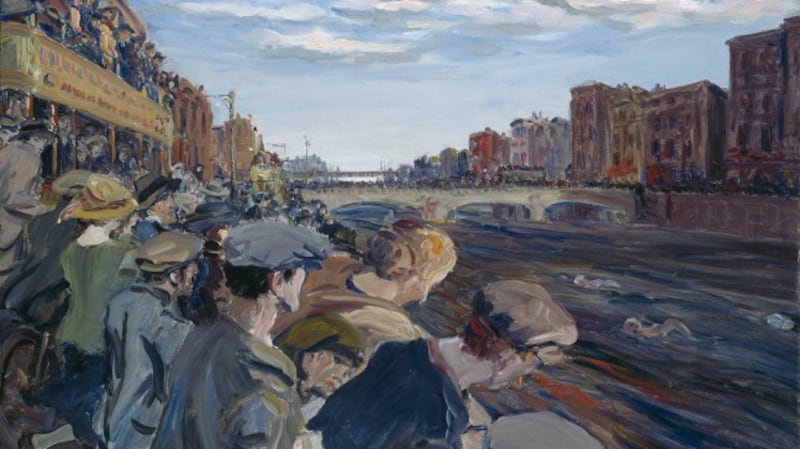It’s a peculiar sort of midlife crisis you’re going through, says one acquaintance. There’s an immediate qualifier. “Post”, he adds. Post midlife crisis. In my 51st year, I’ll take any brickbats thrown my way when it comes to notions of self-invention as some sort of late-life athlete. From the start, let’s not overstate this – late-life enthusiast is the state I’m after.
So why open-water swimming? It started with a casual conversation with Swim Ireland coach Peter Conway in The Irish Times canteen late last year. A lapsed pool swimmer since my teenage years, I had made tentative reconnections with the sport through the Swim Ireland Swim for a Mile Challenge over the previous two years. True to form, though, each year I relapsed into inactivity almost the moment I touched the pool wall after the 64-length pool challenge was met. I needed further motivation, a bigger challenge, preferably with structure and somebody to tell me what to do.
Swim Ireland's plan to provide a bridge from the pool mile to the open water by means of an August lake swim seemed the ideal vehicle. Mentioning a long-held, albeit somewhat vague, ambition to complete the Liffey Swim took it up a notch or 10. Seized upon by Coach Conway, I had suddenly signed up to a new-year training programme with the prospect of multiple open water qualification swims to make the Liffey start line. It was still December. I saved the Jack Yeats Liffey Swim painting as my new screensaver. Job half done.


Seven months on and I’m a veteran of nine open water swims and the Liffey Swim is coming up quick. A few choppy moments aside, the journey has been surprisingly smooth. The difficult first steps of regular pool sessions were helped by the involvement of work colleagues. Sharing a common goal to complete the pool mile by April, twice weekly sessions built up our swimming endurance and honed technique. The mile was duly completed, in both 25 metre and 50 metre pools.
The transition to the sea was next up. As pool sessions continued, there was no getting away from it that I needed to dip my toe and a lot more in the open water. Introduced to the partially hidden swimming idyll of Low Rock near Malahide, I joined a group of regular swimmers there in late May.
There is no getting away from the cold. Being a gentleman of generous size – big unit I think they’d say in other sporting circles – undoubtedly helps. I learned to cope with it relatively quickly to the point where it’s rarely an issue any more. My policy is no messing about – get in, get down, swim; the issue of the cold is soon left behind.
No rest
Other issues replace it, however. Open-water courses are generally around the mile mark. Sometimes you swim point to point, but more often the courses are circular and involve swimming around up to a half dozen buoys. The lack of pool walls to break up the swim – for a boost, a rest, a crutch, whatever – continues to be difficult to get my head around. Sighting the next buoy can be difficult too and an 1,800-metre course can easily become 2km when you’re not careful. For elite racers, getting and taking a good line can be the difference between winning and losing.
Oh yes, the races. The Low Rock training sessions have been replaced by fully fledged races. The Leinster Open Sea circuit has 30 or so races on its calendar. Every week up to 200 men and 150 women participate. With no wet-suits allowed, swimmers receive time handicaps according to ability. It theoretically gives all-comers the chance to shine.
In truth, the handicap guards against humiliation and ensures everyone finishes within 15 or 20 minutes of each other. An elite group compete for the swimmer of the year prize but over 50 per cent of the field has a chance of glory and one day in the sun. For the rest of us, taking part and completing the course gives more than sufficient satisfaction.
Men and women swim in separate races, due to a fear that in the hustle and bustle of open-sea swimming, injury can and does occur. Certainly the experience of being swum over was new to me, but it does happen. A packed field going around a buoy takes no prisoners.
It’s every man or woman for themselves, particularly when the late starters – the really fast swimmers – get the smell of victory. Your defence is: switch your leg-kick to turbo – okay, increase the rhythm enough to let them know you’re there and alive – and keep your elbows high out of the water. In the one race that men and women started together, from Ireland’s Eye to Howth beach, long-distance specialist Rachel Lee was fastest.
Singular pursuit
By its very nature, swimming is largely a singular pursuit. Unlike running or cycling, there’s no opportunity for chit-chat or shooting the breeze while negotiating a course. It’s a head-down affair, you against the water and prevailing conditions. Not to mention that for me it quite often becomes a “Christ, where is that last buoy and finish line” act of desperation.
Yet the circuit is unexpectedly social as fellow competitors and enthusiasts share war stories (about the cold, the vagaries of the handicapper and the perils of choppy waters and angry jellyfish). Mostly there is encouragement.
The men from Aer Lingus Masters, whose banner I swim under, have provided me with much help, motivation and inspiration. While many of them compete for top 10 finishes, they never lack for interest in my latest one-hundred-and-something placed finish.
The intimacy of the circuit also allows you brush up against genuinely elite endurance athletes. Thefeats of Sabrina Wiedmer or the training regime of channel swimmer hopeful Willie Irwin are things of wonder. (Note: when I say brush up against I mean change at the same place and get into the water around the same time).
It has also opened up the Dublin coast to me. Almost 35 years living in Dublin and it is only this summer that I’ve discovered the pleasures of Seapoint and Killiney beaches and Malahide’s Low and High Rock. I got to see Cork differently too when I joined my brother Denis for the recent Lee Swim.
If you’re in Dublin city centre on Saturday August 6th, there will be up to 400 or so of us wending our way down the Liffey. The start is near the Guinness gates, close to the Rory O’Moore Bridge. Look out for me – I’m the post midlife crisis one with the built-in insulation that also acts as a flotation device.
Do you want to Get Swimming? Follow our pool plan to learn to swim for a mile – it doesn’t matter what time of year you start.
Find our videos and training plan on irishtimes.com/Get Swimming








